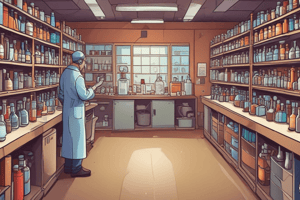Podcast
Questions and Answers
What is the result of adding ammonia water to AgCl?
What is the result of adding ammonia water to AgCl?
- It turns black
- It forms a white precipitate (correct)
- It remains unchanged
- It dissolves completely
How does the presence of metallic mercury manifest?
How does the presence of metallic mercury manifest?
- It remains colorless
- It forms white precipitates
- It turns gray upon acidification
- It turns black in color (correct)
What signifies the presence of Hg2Cl2 in the reaction?
What signifies the presence of Hg2Cl2 in the reaction?
- Yellow precipitate
- No precipitate formed
- Gray precipitate
- White precipitate (correct)
Which color does mercurous ions precipitates appear in?
Which color does mercurous ions precipitates appear in?
Why do all samples show an absence of mercurous ion in the experimental results?
Why do all samples show an absence of mercurous ion in the experimental results?
What is the color of the precipitate formed when lead (II) ion reacts with potassium chromate?
What is the color of the precipitate formed when lead (II) ion reacts with potassium chromate?
Which unknown samples showed yellow precipitations in the experimental results?
Which unknown samples showed yellow precipitations in the experimental results?
What is the separating agent used to separate silver and mercurous ion in the analysis procedure?
What is the separating agent used to separate silver and mercurous ion in the analysis procedure?
What is the color of the precipitate formed when silver ion reacts with nitric acid?
What is the color of the precipitate formed when silver ion reacts with nitric acid?
How is silver chloride separated from mercurous chloride based on their solubility?
How is silver chloride separated from mercurous chloride based on their solubility?
What does the efficiency of separation of silver ions from mercurous ions depend on?
What does the efficiency of separation of silver ions from mercurous ions depend on?
What is the main purpose of the group precipitation procedure in the given text?
What is the main purpose of the group precipitation procedure in the given text?
Why is it important to use colorless solutions instead of clear solutions in the given procedures?
Why is it important to use colorless solutions instead of clear solutions in the given procedures?
Which of the following cation groups becomes insoluble when they form chlorides according to the text?
Which of the following cation groups becomes insoluble when they form chlorides according to the text?
Why is it mentioned in the text that lead chloride may remain as a white residue after leaching with hot water?
Why is it mentioned in the text that lead chloride may remain as a white residue after leaching with hot water?
What characteristic of lead chloride makes its separation and identification challenging in the procedures described?
What characteristic of lead chloride makes its separation and identification challenging in the procedures described?
Why does lead chloride have high solubility in water?
Why does lead chloride have high solubility in water?
What is the purpose of the lab described in the text?
What is the purpose of the lab described in the text?
How is the solubility product constant (Ksp) defined?
How is the solubility product constant (Ksp) defined?
How does the Ksp value relate to solubility?
How does the Ksp value relate to solubility?
What does the comparison of lead chloride to silver chloride and mercurous chloride solubilities reveal?
What does the comparison of lead chloride to silver chloride and mercurous chloride solubilities reveal?
Why is examination as to color limited in determining the solution's identity?
Why is examination as to color limited in determining the solution's identity?
Why are good organizational skills and techniques considered essential in this lab?
Why are good organizational skills and techniques considered essential in this lab?
What is the purpose of keeping a 'waste' beaker near the work area?
What is the purpose of keeping a 'waste' beaker near the work area?
How can cross-contamination affect lab results?
How can cross-contamination affect lab results?
What is the recommended method to clean glassware between uses?
What is the recommended method to clean glassware between uses?
How is the pH of a solution tested using litmus paper?
How is the pH of a solution tested using litmus paper?
Which of these may indicate a positive test according to the text?
Which of these may indicate a positive test according to the text?
What does 'centrifugate/supernatant' refer to in the context provided?
What does 'centrifugate/supernatant' refer to in the context provided?
Flashcards are hidden until you start studying




